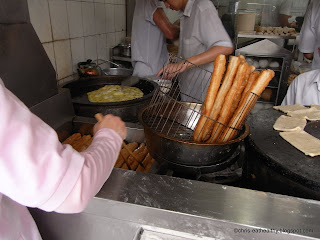During my week-long stay at my parents’ place (in France) we did not have to buy vegetables. My parents have a vegetable garden and there was an abundance of tomatoes, green beans, eggplants and zucchini.
Like most French people in July we started our lunch with the traditional tomato salad. Either topped with olive oil, crushed garlic and chopped basil, or mixed with white onion & green bean and Italian dressing. I never got tired of eating these refreshing appetizers made with our home-grown veggies.
 |
| Veggies picked from the garden |
 |
| Tomato with garlic and basil salad |
 |
| Preparation of tomato salad with white onion and green beans |
 |
| Cooked green beans (in colander) |
As a main dish we had zucchini almost every day. We had them stuffed (courgettes farcies), baked, stir-fried, and also in stew. Without forgetting the most popular dish made with courgette which is (I think) the ratatouille. (See below my recipe). Although I make it here in Hong Kong it never tastes the same as my Mum’s. Must be the quality of the veggies, or is it the family atmosphere, the French environment, or the fact that I am on holiday and have more time to enjoy food? Maybe each one of these reasons makes the ratatouille in France taste better.
 |
| My ratatouille (in Hong Kong) |
My Mum knows that I love soups even in summer and one evening she made a zucchini potage that I have never had before (recipe recently given by one of her girlfriends). On that evening I looked at my Mum making the quick and creamy soup. Here is how she proceeded:
She cut a large courgette freshly picked from her vegetable garden in large chunks, placed the pieces in salted boiling water and cooked them until tender. Afterwards she added 4 cream cheese wedges (Vache Qui Rit – The Laughing Cow) and blended the mixture until it became smooth and creamy. Et voilà! I really enjoyed her soup.
 |
| Big chunks of zucchini |
 |
| ...in boiling water |
 |
| My Mum blending the mixture (zucchini & VQR) |
 |
| Et voilà! |
This time I did not have the chance to enjoy one of my paternal grand-mother’s dishes: zucchini alla scapece. My grand-mother was born in France from Italian parents and used to make it in summer. This is a Neapolitan specialty. Scapece means pickling. This recipe (which has been adapted to suit her cooking) is made with deep-fried sliced courgettes, red-wine vinegar, onion, garlic and sage. This dish is best prepared one day in advance and served at room temperature. It is an excellent summer entrée. If the oil temperature is right the veggies should not absorb too much oil and the salad will not be greasy. Furthermore it is said that vinegar breaks down fat so we should not feel guilty (or unhealthy) for eating more of it. But let me tell you a secret: “This dish is delicious and most often I have to restrain myself from taking a second helping”. Why not having another portion? Because this is only the starter and more dishes are coming! Ah, and sorry I don’t have any picture to show you here as my Mum did not have time to make it for me this time… and I never tried to make it myself in Hong Kong (not yet!).
Ratatouille
Ratatouille is very popular especially in the south of France. It is made during the summer when it is the zucchini’s season. Ratatouille is often served hot as main dish or an accompaniment to meats. It can also be eaten as an appetizer. Simply put a dollop of chilled ratatouille on a slice of toasted bread (as you know I love bread!), cracker or bruschetta.
 |
| Ratatouille on my home-made bread |
 |
| Ratatouille on bruschetta |
Ingredients:
- 60 ml olive oil
- 4 cloves of garlic, minced
- 1 onion, diced
- 2 courgettes/zucchini/jade melon, cut into pieces
- 2 eggplants, sliced
- 400 g (1 can) chopped tomatoes (or fresh ripe tomatoes)
- 1 sprig of thyme
- 1 bay leaf
- Fresh basil leaves, thinly chopped
- Salt and ground black pepper
Steps:
1. Heat about 20 ml of olive oil in a large skillet
2. Add the garlic, onion and a pinch of salt. Cook over a low heat until the onion is transparent.
3. Add the courgettes and cook until it is slightly softened. Discard the vegetables.
4. Heat about 40 ml of olive oil in the skillet.
5. Add the eggplants and cook, stirring often, for about 5 minutes.
6. Return the vegetables (onion, garlic, and courgettes) to the skillet and stir.
7. Add in the tomatoes, thyme and bay leaf. Lower the heat and cook, stirring often, until the vegetables are tender, or about 40-45 minutes.
8. Add salt and pepper to taste.
9. Allow to cool and reheat for 15 minutes just before serving. Remove bay leaf and thyme.
10. Garnish with basil leaves on top of dish.
 |
| Ratatouille (mine!) |
Don’t let the appearance of the dish fool you. The flavour won’t disappoint you! Stews often taste even better reheated then when first cooked.
Bon appétit!














































